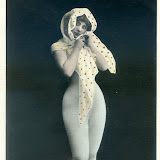Anthony Comstock and erotic photography
No sect nor class has ever publicly sided with the smut dealer, except the Infidels, the Liberals and the Free-lovers"
Anthony Comstock
Anthony Comstock cut a formidable swathe through New York Society between 1873 and 1910. Being a postal inspector he had some idea of what was passing through the city’s mailrooms and as head of the New York Society for the Suppression of Vice he was given the power to clean them up. In 1873 he announced that over the previous two years, alongside more than five tons of books, 21 000 impure song sheets, 5000 obscene microscopic watch and knife charms, 5 500 obscene playing cards and 30 000 immoral rubber articles, he had overseen the destruction of 182 000 obscene photographs. That suggests there was a fair amount of salacious photography in circulation, and or Comstock had a broad definition of pornography. It’s unlikely he would have been persuaded that a flesh coloured body stocking protected anyone’s virtue. A nude was a nude no matter what she wore.
Comstock argued that anyone who photographed a nude was a grubby and seditious pornographer, the type of character who skulked around back alleys and seldom washed. After several raids and attempts at entrapment of Weil’s studio on Broadway, he uncovered a portrait of the photographer’s naked infant son, which was enough in Comstock’s opinion to call in the police. One could never underestimate the cunning of a smut dealer or the vulnerability of young minds. Comstock’s witch-hunt extended to photographs of artworks even though the originals were on public display in museums. Many, probably most of the photographs circulating through the city actually originated in Europe; the number of New York photographers active in the porn trade was lower than Comstock wanted people to believe.
He also insisted that the women who posed nude for a photographer were innocent victims and cruelly exploited. The same idea would get some traction among feminists in the 1980s though in Comstock’s late Victorian world view suffragism was an evil on a par with pornography. Any woman who dared challenge his concept of marriage or suggested women should establish more economic independence was also a target. The New Woman movement emerging towards the end of the century had no fixed manifesto but its members tended to be straitlaced when it came to theories of work and economics. By ‘profession’ they meant law, medicine, business or education. Being an artist’s model was a little frivolous.
It followed however that if men like Comstock were as virulently opposed to suffragism as they were pornography, then eroticism could be used as a form of protest. For some performers it was definitely liberating. The photos of ballerina Regina Badet on display here are relatively chaste; she was not the slightest bit ashamed at undressing for the camera and whenever she did she appeared to be cocking a snook at someone. Women didn’t have to take off their clothes to rile the Comstockians. Smoking, drinking, dressing as a blacksmith or even just implying lesbianism, any behaviour that transgressed the image of the obedient woman was subversive.
Most of the women in this gallery are anonymous and we can’t be absolutely sure what their intentions were. They don’t look like victims. A few of them would be aspiring actresses, which has always carried a sense of being exploited, but appearances are everything, as Comstock well understood. It is enough to look like you enjoy breaking the rules to become dangerous to certain eyes. We could consider these photos as exploitation of women’s bodies but they could also be act of defiance.
 |
| BAD GIRLS |






No comments:
Post a Comment
Add comments here